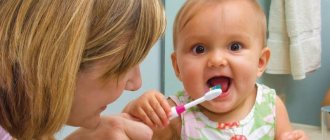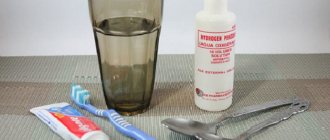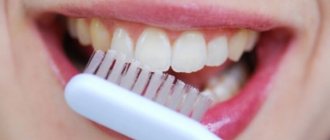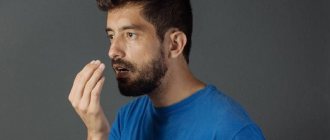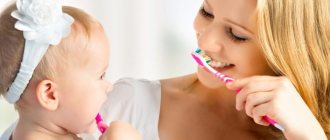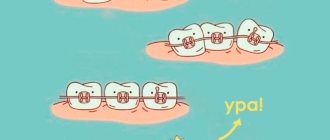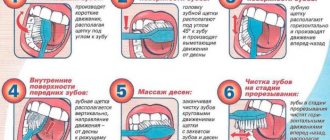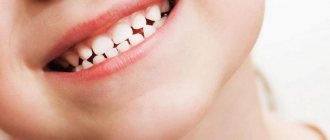From the moment children's first teeth appear, they need care. Dentists recommend teaching hygiene procedures as early as possible, but they do not recommend imposing a healthy habit. Experienced mothers know that getting a child to brush their teeth is very difficult. Children are capricious, express dissatisfaction and resist. To solve the age problem, special tricks and educational approaches are needed. To make the new procedure a favorite pastime, start by finding out the reasons for your reluctance to brush your teeth. This could be a hard brush, painful sensations, ordinary laziness, or the goal is to attract attention when there is a lack of it. Eliminate all irritating factors and try to come to an agreement with your baby.
The child does not want to brush his teeth, how to persuade him. Tips and tricks
The condition and future of root teeth depends on proper and timely care of milk teeth. The first teeth that have erupted are carefully wiped with a piece of gauze soaked in water. It is advisable to do this in the morning and evening so that the baby gets used to the mandatory procedure. Correct hygiene in infancy serves as an excellent preventive measure and protects against the possible development of fungal and bacterial infections.
A 1.5 year old baby is already able to perceive and evaluate information. He understands what they want from him and why they take him to the bathroom in the morning. But not everyone is ready for this innovation in their lives and is reluctant to undergo the procedure. During this period, walks, games and cartoons are a priority, so a daily activity in the bathroom may seem boring to many. When attempts to force or persuade are unsuccessful, try to play on children's impressionability. Let's highlight the most popular tricks and tricks that work effectively and help parents teach their child to brush their teeth.
- Diversify and enliven your daily routine. It shouldn't be boring. You can turn on music, read poems, tell fairy tales, and come up with exciting games. Surround your baby with the company of your favorite dolls, bears and bunnies. Make it a fun activity where everyone brushes each other's teeth. If the child likes it, next time you won’t have to persuade it.
- Go shopping for a toothbrush and toothpaste together. There are a lot of tempting and bright children's models for sale. Young children are attracted, first of all, by the appearance of the accessory and the delicious pasta. Usually preferences are on the side of beautiful brushes with your favorite cartoon characters and the sweet taste of the toothpaste composition. But even the most interesting things can quickly become boring, so you can buy several devices at once.
Remember safety. Children often swallow the paste. To avoid harm to the stomach, purchase formulations without fluoride. The brush should be soft so as not to scratch the gums, and comfortable so that the baby can hold it in his hands without any problems.
- Teach the skill of brushing teeth by example. This is one of the best educational approaches, as children love to imitate adults. They copy gestures and behavior, and all movements take root in their consciousness for a long time. Don't close the bathroom door when brushing your teeth. At first, the baby will watch with curiosity. You can be sure that he will want to join and repeat your actions. An excellent type of motivation is the element of competition. Compete to see who can brush longer or who has whiter teeth. In such competitions, children really like to win against adults.
- Don't over-praise! The child must understand that brushing teeth is a mandatory procedure. There is no need to persuade him, encourage him after each attempt and throw around promises. If the smart guy understands that he will be rewarded every time, he will get used to it and will take up the brush only if his next wish is fulfilled.
You can praise for success, encourage and emphasize that clean, white, strong teeth are great. If your arguments do not work, be patient and do not resort to punishment with a belt. This only works at an early age and can lead to the fact that an unpleasant childhood association will cause reluctance to care for the oral cavity in adulthood.
What do dentists recommend?
You can cast aside all doubts about your baby’s oral hygiene by consulting a pediatric dentist. You can find a competent specialist for your child on our portal. A convenient navigation system will help you view the rating of the clinic and doctor and choose a convenient location.
If you have been accustomed to massage and brush your gums since infancy, switching to a toothbrush will be easy. A habit developed in childhood will last a lifetime.
To avoid the development of caries, visit your dentist for a preventive examination. The doctor will show you how to hold the brush correctly, how much paste to apply at a time, and what movements to make with the brush.
General recommendations from a pediatric dentist:
- Up to 6 months, clean your mouth and teeth with gauze and water, and dental wipes.
- When the first tooth erupts, start using a toothbrush exclusively for children; you need to change it at intervals of two months, and also every time after a cold. Artificial bristles, a head the size of two baby teeth, a thick handle that is easy to grip.
- Use toothpaste after 2 years. Teach not to swallow it, but to spit it out. Without abrasives, gel-like texture or classic. Flavor options from neutral to fruity at your discretion. A pea-sized volume is enough to effectively remove plaque and bacteria. It is better for older children to use a fluoridated product to prevent it from entering the stomach, as this can cause poisoning.
- Carry out hygiene after eating in the morning and before going to bed in the evening. Increase the procedure time gradually, placing priority on the quality of the procedure and the correctness of the procedure.
- Hold the brush at a 45-degree angle, use sweeping movements: for the upper teeth it is necessary to go from top to bottom, for the lower teeth - from bottom to top on both sides, and the chewing surface needs horizontal circular movements.
- After eating, it is better to rinse your mouth with water every time to get rid of food residues.
- Cleaning the tongue.
Hygiene procedures and age characteristics of the child
At the age of 1 to 2 years, it is unlikely that it will be possible to force children to brush their teeth on their own. When the child picks up the brush for the first time, he will simply play with it. Don't disturb him, let him get used to the accessory. When helping the baby, be careful and careful in your movements. Any discomfort and pain can discourage you from caring for your teeth for a long time.
The ideal age for independent mastery of skills is 2–3 years. At this age, kids go through a very interesting period called “I myself.” They are eager to try everything and they need to take advantage of this moment. Get interested in the process by your own example and show how to properly brush your teeth. If necessary, guide the baby's hand, praise him and never scold him if he fails to cope with the task. It is these first inept attempts that allow you to remember the movements and hone your skills over time.
If a child under 5 years old categorically refuses to go to the bathroom and pick up a toothbrush in the morning, take a break. Let him forget unpleasant associations and impressions. During this period, you can read useful books and unobtrusively offer special educational cartoons, which tell in an entertaining way the importance of daily brushing and caring for your teeth. Tell stories about children who don’t take care of their teeth and show pictures that clearly show what protest can lead to. It is easier to convince, persuade and teach an interested child. The main thing is that the initiative comes from him, otherwise repeated attempts will result in failure.
When teaching a skill, do not frighten children. You won't achieve anything by making up stories about evil microbes and monsters called Caries that come and take your teeth. Horror stories will only do harm and completely discourage you from picking up a toothbrush. Do not traumatize the child's psyche.
There are difficult cases when at 7 years and older children do not want to brush their teeth. Persuasion and coercion will no longer work, but persistence without shouting, hysterics and coercion can be demonstrated in such situations. Go to the dentist. Good children's specialists know what to say about the importance of hygiene procedures and will definitely help with advice.
Let me practice
Having become interested in a new activity, the child will want to try it out - perform the procedure for its own sake, for the sake of creating an understanding of the process and consolidating the skill. If initiative is not impeded, then such immersion in the process will provide an opportunity to fully develop motivation and the necessary skills.
The child may become so interested that he will ask to brush his teeth or rinse his mouth several times a day. Don't suppress desired behavior to save supplies. Once the novelty wears off, the work begins to turn the process into a daily ritual.
While the baby himself strives to brush his teeth every couple of hours, it is worth taking advantage of this without negative comments. Thanks to this, the process will integrate well into your daily routine, and there will be no need for reminders.
conclusions
By the age of 8, children should be able to fully brush their teeth independently. If the habit has not been formed before the age of 11, then mistakes were made in educational approaches and training. One of the main ones is coercion. The fact is that, unlike adults, children do not understand the importance and benefits of daily hygiene procedures. They treat this as a duty and often resist.
You can’t force someone; this usually causes even greater protest. You can be persistent, but within reasonable limits. It is advisable to instill the skill of caring for the oral cavity at an early age. Children who are one year old already understand what is wanted from them. During this period of active imitation, they react with pleasure to everything new and interesting. Don't expect quick adaptation and results. The main task of parents is to convince them of the usefulness of brushing their teeth and not discourage them from practicing basic hygiene rules.
Which toothpaste to choose for a child
The choice of toothpastes for children 3–8 years old is slightly wider than for toddlers - the child has already learned to spit out the toothpaste, so it may contain fluoride.
When choosing a toothpaste with fluoride, look at the safe concentration of this component - this is 500-900 ppm for children from 3 to 8 years old.
In addition to paste, you can use gels that strengthen the enamel. For example, Tooth Mousse - it helps to get rid of increased sensitivity and prevent the development of caries. There is no sugar in it, and the main components of the gel are calcium and phosphates, which are necessary for dental health. Remineralizing gel can be applied after brushing directly to the teeth or in special trays.
What should not be in baby toothpaste?
The fact that a child has already learned not to swallow toothpaste does not mean that he will not do this if the paste is especially tasty. For such cases, manufacturers have excluded harmful substances from the composition and found substitutes for them.
Children's toothpaste should not contain SLS and parabens. If the paste foams, it means it contains SLS, and it is better to discard it.
In addition, for proper care it is important that the baby toothpaste contains a minimum amount of abrasive substances. Soft abrasives are necessary for effectively cleaning teeth from plaque in adulthood, but there should be little of them in the composition of children's toothpaste. On the packaging, the degree of abrasiveness is indicated by the abbreviation RDA and for children ranges from 0 to 50.
What substances are useful in baby toothpastes?
Pay attention to the composition when choosing a new toothpaste for your child. You already know what should not be in the composition. Useful substances include fluorine and hydroxyapatite (or nanohydroxyapatite).
- Fluoride is an important substance for teeth, so toothpaste should contain a small amount of fluoride, which is usually indicated on the package. For children under 4 years old - 200 ppm, from 4 to 8 years old - 500 ppm.
- Hydroxyapatite is a modern alternative to fluorine. Synthetic hydroxyapatite is identical to the natural one that makes up enamel. It easily integrates into its crystal lattice and strengthens it, sealing microcracks and reducing sensitivity. In addition, hydroxyapatite eliminates caries at the white spot stage.
- Flavoring additives. This is not the most important and useful component - its choice depends on the preferences of the child himself. But it is important to know that flavors in children's toothpaste do not have to be of natural origin. Now special synthetic analogues have been developed that are completely safe if swallowed.
Toothpaste Dentissimo Junior Apple (from 6 years old)
Toothpaste ROCS (ROCS) Kids Berry Fantasy (from 4 to 7 years)
Toothpaste Brush-Baby Multifruit (from 3 to 6 years)
Biorepair Kids toothpaste with strawberry flavor (from 0 to 6 years)
Watch
If the child resists, observe what may be causing his discomfort. A small child feels pain differently than adults: what is a slight prick for us resonates throughout the baby’s whole body. And since our goal is to teach gently and without injury, we should be sensitive to the child.
Common reasons why a child does not want to brush their teeth:
- the toothbrush has too hard bristles or an uncomfortable handle;
- toothache or gum inflammation;
- don't like the taste of toothpaste;
- psychological discomfort from cleaning by adults;
- the procedure is associated with unpleasant memories;
- The baby does not have the opportunity to show independence.
The child needs our help to overcome all these obstacles.
Offer choice
The choice between “oneself and not oneself” is far from the only one - a child can make a decision at any stage:
- choose a brush to buy;
- each time choose from your two brushes;
- which glass to spit in;
- brush with mom or dad;
- to your favorite music or in silence;
- spitting in the sink or bathroom;
- with eyes open or closed.
The more often we let the child make a choice, the more willingly he joins in the process.
I showed my daughter the options and asked: “Do you want a pink or blue brush?” Now she has two brushes: Pigeon from 12 months (harder) and Сuraprox (very soft). Before brushing, I ask: “Will you wash your face or brush your teeth first?” Further: “Will you clean with a small brush or a big one?”, “Will you squeeze out the paste yourself or should I help you?”, “Will you clean it first or should I?”.
